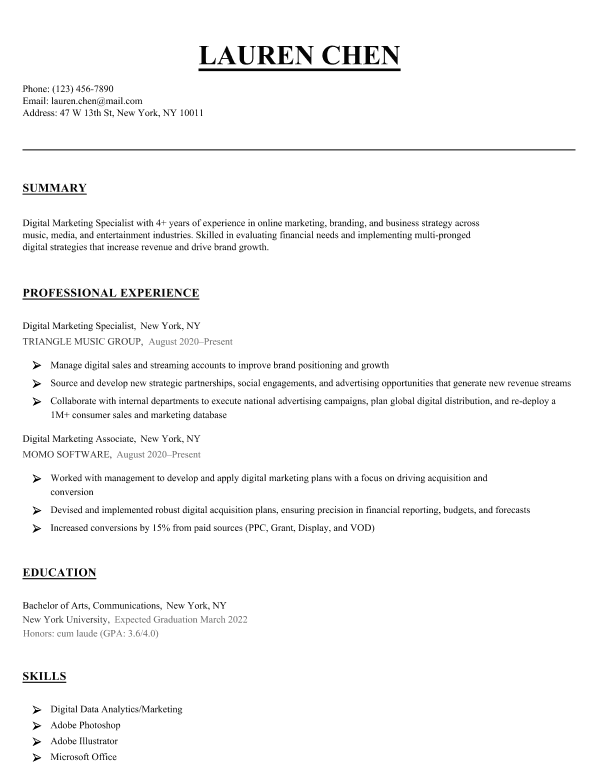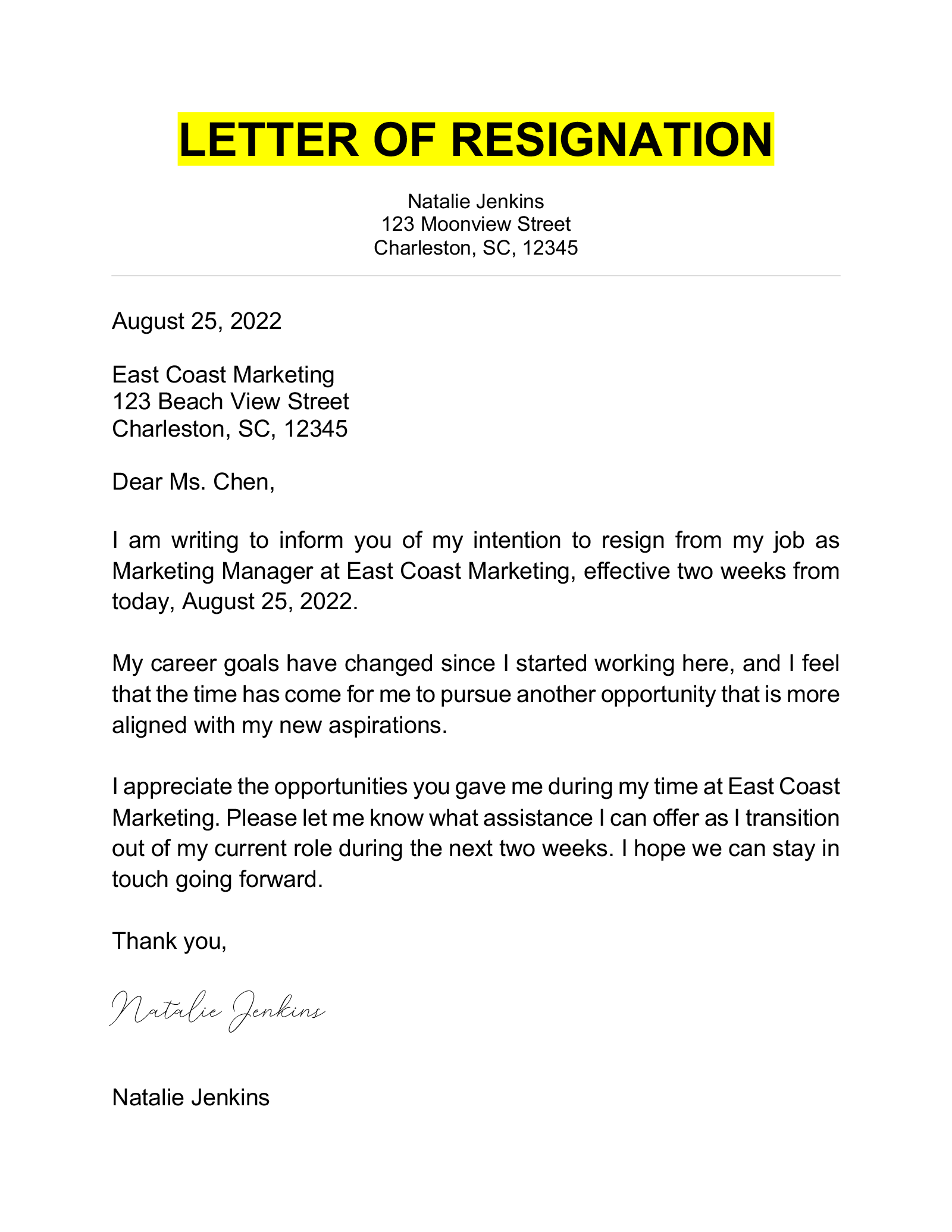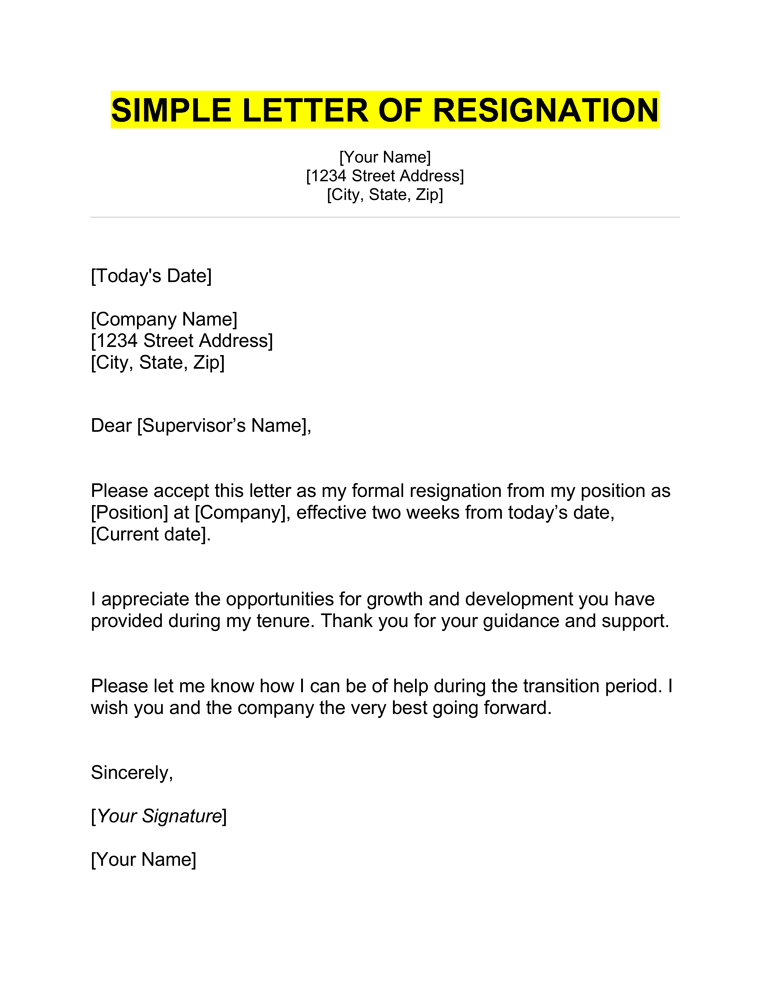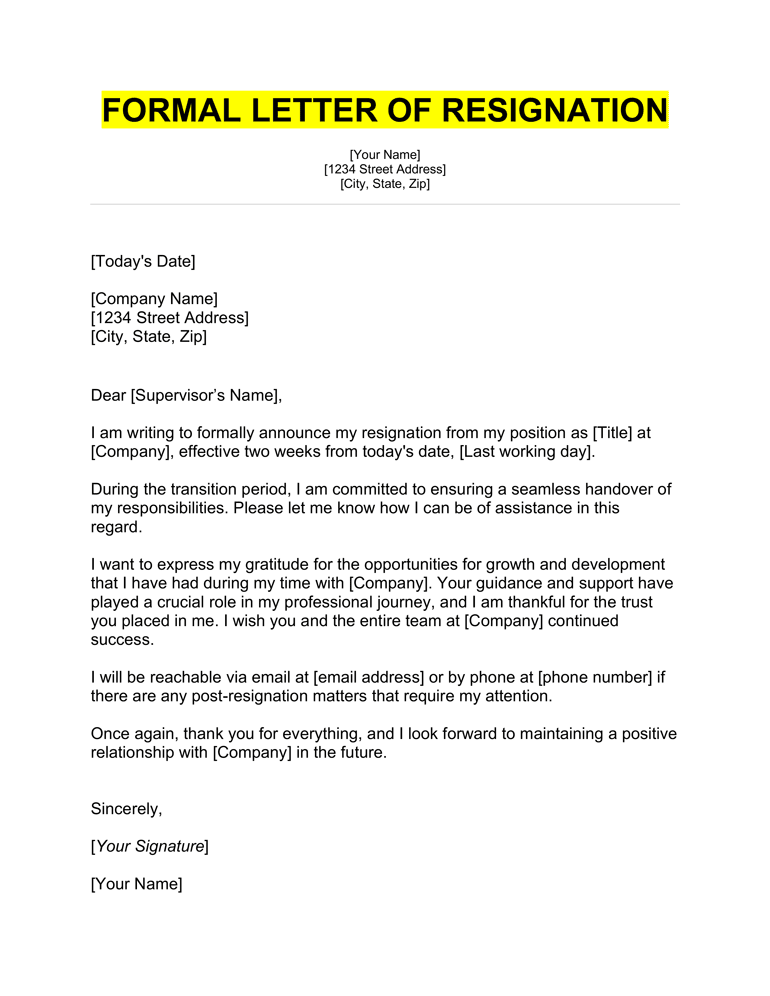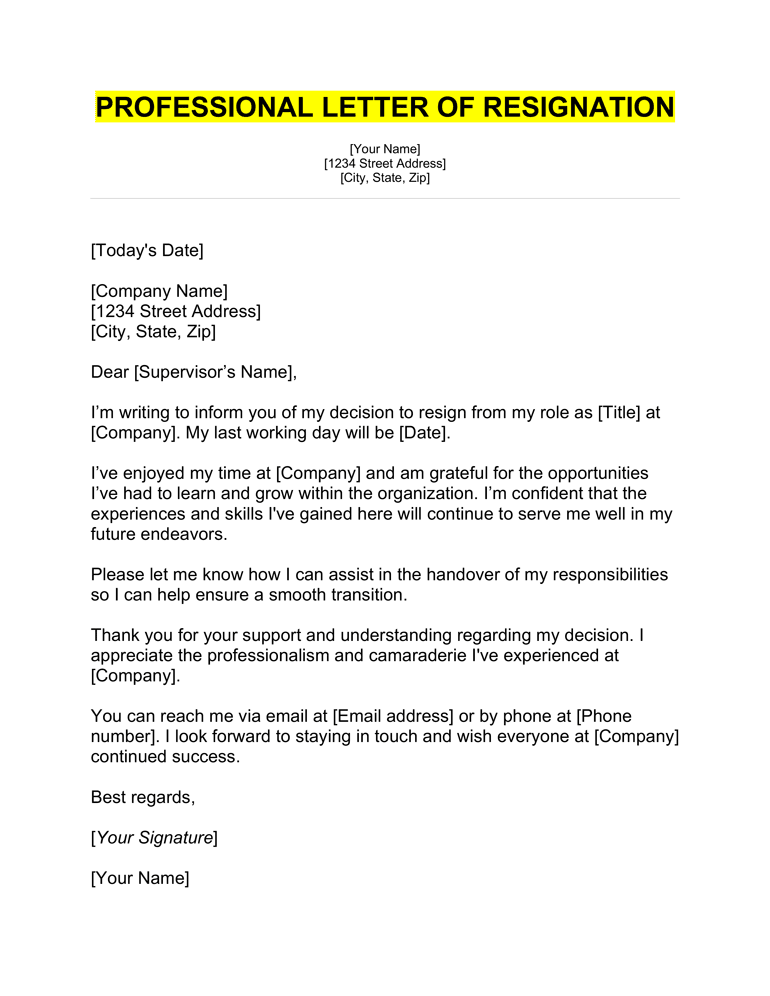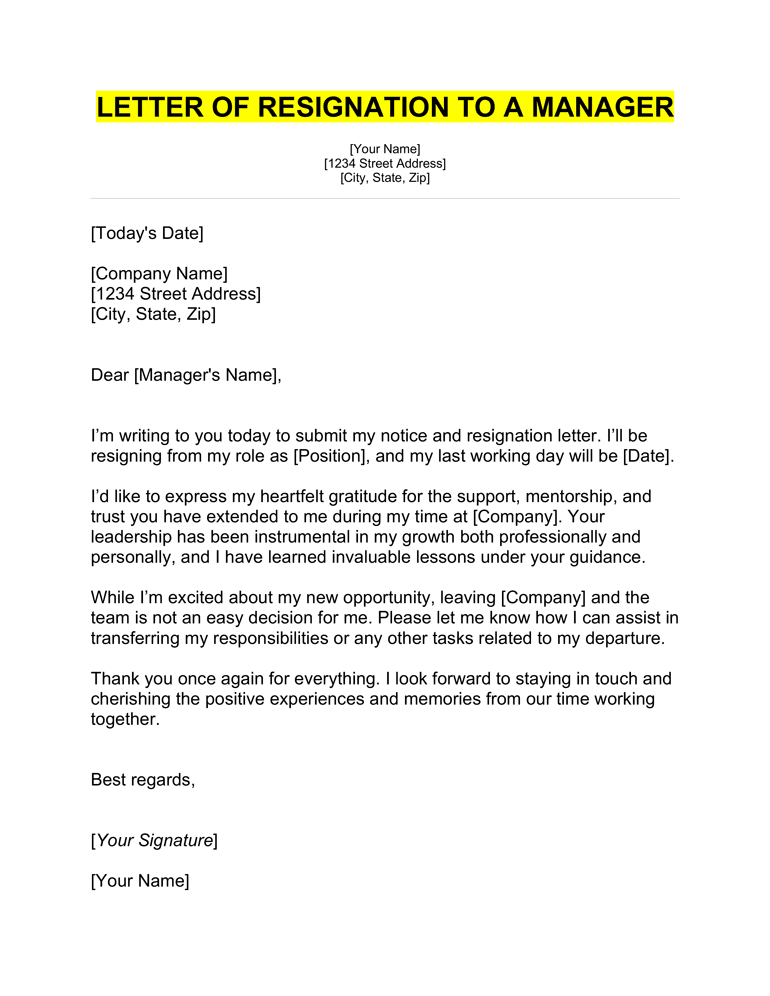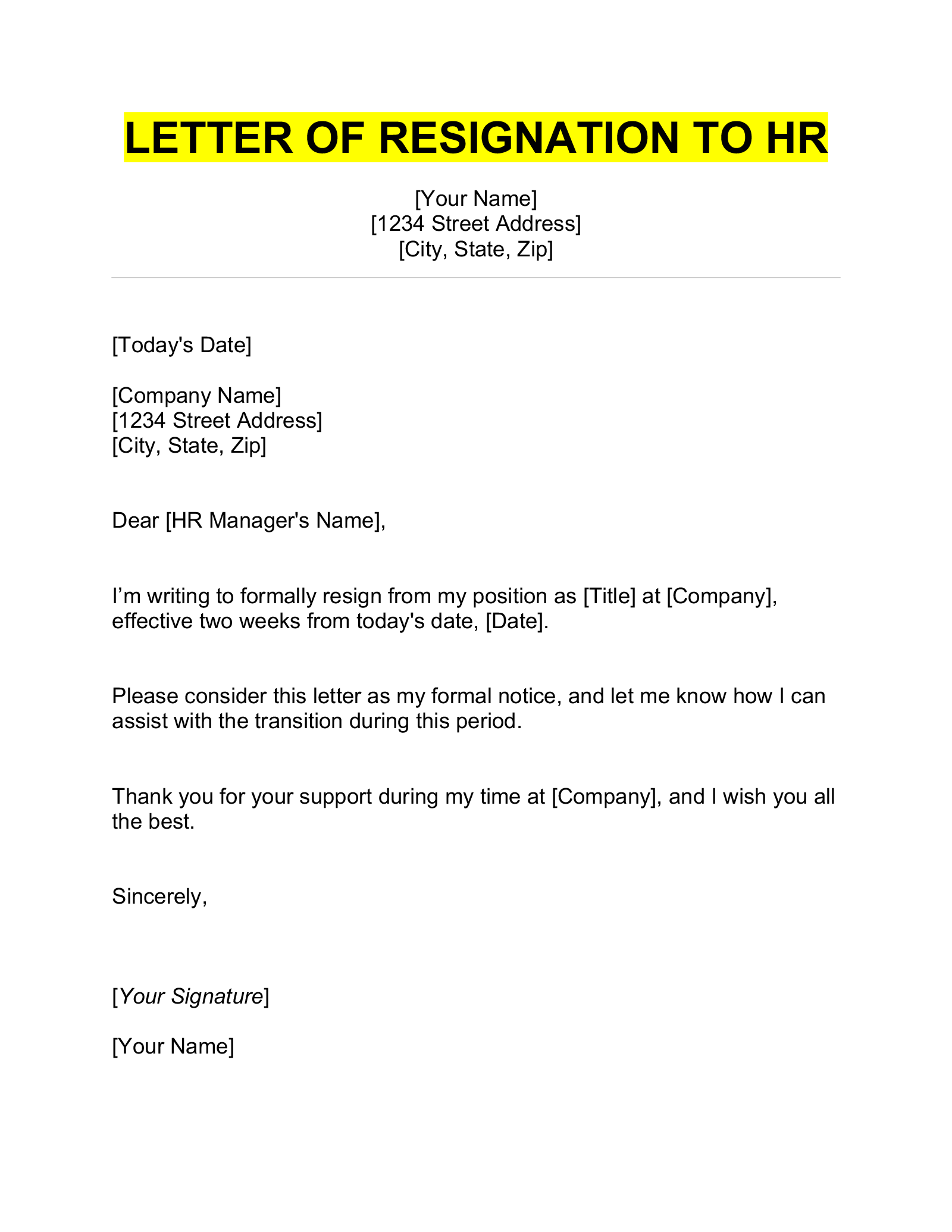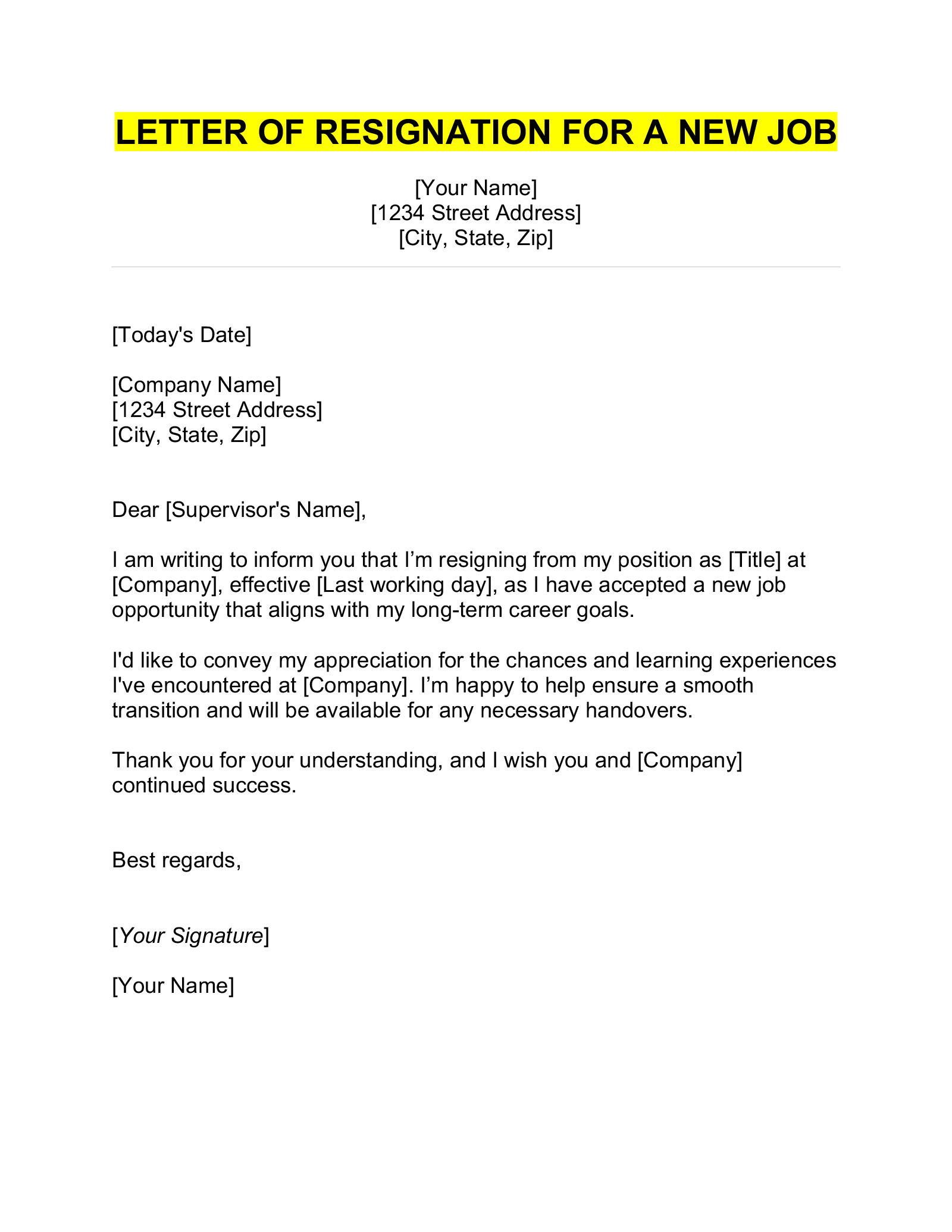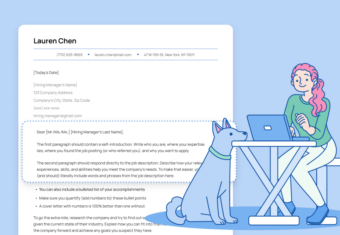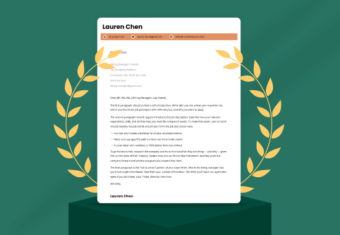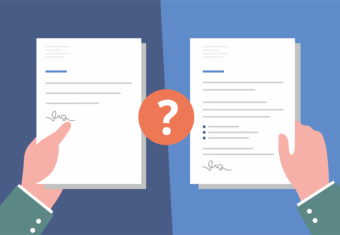When you’re getting ready to quit your job, there’s a mountain of details to think through. One of those details is your resignation letter – should you write one? When should you send it? And how do you write an effective one?
We’re going to make it easy and break down everything you need to know about resignation letters in this article. Here’s what we’ll cover:
Our free-to-use resume builder can make you a resume in as little as 5 minutes. Just pick the template you want, and our software will format everything for you.
What is a resignation letter?
A resignation letter is a formal document or email that lets your employer know you’re leaving your position, and it’s usually sent at least two weeks in advance of a finish date.
Even if you don’t like your job, you should always write a letter of resignation because it’s courteous to give your employer advance notice so they can plan accordingly.
Taking the time to write a polite resignation letter reflects well on you and helps you keep important professional relationships intact, making it more likely that you’ll get those glowing letters of recommendation and positive reviews during reference checks.
If you’re wondering what a resignation letter looks like, here’s an example you can follow:
How to write a resignation letter
Writing a resignation letter sounds like a daunting task, but it doesn’t have to be. Let’s go over everything you need to know to write a proper resignation letter.
1. Figure out who your recipient is
Before you start writing your letter, think about who you’ll be sending it to. Will it be your manager? The HR department? The CEO? Knowing who you’re writing to will help you strike the right tone without coming off as too formal or informal.
If you’re writing your resignation letter to someone you’ve never met in the HR department, maintain a formal tone. If your letter is going to your long-time manager, it’s okay for your letter to be a bit more informal – just keep it professional.
Besides helping you adjust your tone, knowing your audience will help you determine what information is appropriate to include.
Are you writing a resignation letter as a formality for putting in your two weeks’ notice? Then you don’t need to go into too much detail.
Do you want your resignation letter to be the starting point for discussing the transition phase and how you can assist? Then feel free to include some of that information up front.
Do you want to use the opportunity to express gratitude to your manager? If that’s who’s receiving your letter, then that’s totally appropriate!
2. Include all the right elements
To help you draft your resignation letter like the example above, here’s a checklist of what to include:
What to include in a resignation letter
- Your name and address – Use proper business letter formatting and place your name and address in a centered list at the top of the page.
- The date – Left-align the date you submit the letter under your address. Listing the date is important because your company will use it to officially begin your notice period.
- The company address – Put the company name on the first line, followed by the street address, city, and ZIP code.
- A proper salutation – Typically, you should address your manager, but if necessary you can address a whole unit, team, department, or company.
- Your final workday – Tell your employer the exact date you want to quit. Doing so lets them immediately begin planning their next steps, and it helps you avoid the stress of not knowing when you’ll get to leave.
- Your reason for leaving (optional) – Acceptable reasons for leaving a job range from general health concerns and spending more time with family to relocation, retirement, and career changes.
- A thank you to your employer – Thank your employer for the opportunity to work with them. Optionally, offer to help with the transition process, or note your desire to keep in touch.
- A polite sign-off – Write a professional sign-off, like “Sincerely,” or “Thank you,” followed by your name — signed and typed if you’re submitting a hard copy, or just typed if you’re sending a digital resignation letter.
Knowing what to put in your resignation letter is key to ensuring you leave the company on good terms, but it’s equally important to know what not to include. Here’s what to avoid:
What not to include in a letter of resignation
- A critique of your employer – Just like when writing a goodbye email to your coworkers, it’s best to keep a positive tone. A resignation letter isn’t the place to say that you’re unhappy with poor management.
- Foul language – Again, even if you’re leaving because of issues with your boss or coworkers, keep your resignation letter professional. This will prevent you from burning any bridges that could lead to future job opportunities.
- Information about your upcoming plans – Avoid including information about where you’re going next. Your manager doesn’t need to know, and adding it puts you at greater risk of being sabotaged by a disgruntled former employer.
- Spelling mistakes – Before you send off your resignation letter, check it for spelling mistakes.
3. Submit your resignation letter
Once your resignation letter is all written (and proofread), there’s nothing left to do but send it!
You can choose to send your resignation in the body of an email, or attach it as a PDF document in an email. Here’s an example of what an email with an attached resignation letter might look like:
Dear [Manager’s Name],
I’ve thoroughly enjoyed my time at [Company Name] and am grateful for the opportunities I’ve been given and the experiences I’ve gained during my tenure here. However, I’ve decided that it’s time to pursue a new challenge, and am writing to resign from my position, effective October 30th.
I’m enclosing my formal resignation letter outlining the details of my departure. If there are any additional steps or paperwork required on my part, please do not hesitate to let me know.
I look forward to the opportunity to maintain a positive relationship with [Company Name] in the future, and I wish the company continued success.
Thank you once again for everything.
Sincerely,
[Your Name]Resignation letter templates
Here’s a selection of letter of resignation templates you can download as a Microsoft Word document (or click the dropdown below each one to copy and paste the text version):
Simple letter of resignation template
Simple resignation letter template (copy & paste)
Simple Letter of Resignation Template
(Your Name) (1234 Street Address) (City, State, Zip)
(Today’s Date)
(Company Name)
(1234 Address)
(City, State, Zip)
Dear (Supervisor’s Name),
Please accept this letter as my formal resignation from my position as (Position) at (Company), effective two weeks from today’s date, (Current date).
I appreciate the opportunities for growth and development you have provided during my tenure. Thank you for your guidance and support.
Please let me know how I can be of help during the transition period. I wish you and the company the very best going forward.
Sincerely,
(Your Signature)
(Your Name)
Formal letter of resignation template
Formal resignation letter template (copy & paste)
Formal Letter of Resignation Template
(Your Name) (1234 Street Address) (City, State, Zip)
(Today’s Date)
(Company Name)
(1234 Address)
(City, State, Zip)
Dear (Supervisor’s Name),
I am writing to formally announce my resignation from my position as (Title) at (Company), effective two weeks from today’s date, (Last working day).
During the transition period, I am committed to ensuring a seamless handover of my responsibilities. Please let me know how I can be of assistance in this regard.
I want to express my gratitude for the opportunities for growth and development that I have had during my time with (Company). Your guidance and support have played a crucial role in my professional journey, and I am thankful for the trust you placed in me. I wish you and the entire team at (Company) continued success.
I will be reachable via email at (Email address) or by phone at (Phone number) if there are any post-resignation matters that require my attention.
Once again, thank you for everything, and I look forward to maintaining a positive relationship with (Company) in the future.
Sincerely,
(Your Signature)
(Your Name)
Professional letter of resignation template
Professional resignation letter template (copy & paste)
Professional Letter of Resignation Template
(Your Name) (1234 Street Address) (City, State, Zip)
(Today’s Date)
(Company Name)
(1234 Address)
(City, State, Zip)
Dear (Supervisor’s Name),
I’m writing to inform you of my decision to resign from my role as (Title) at (Company). My last working day will be (Last working day).
I’ve enjoyed my time at (Company) and am grateful for the opportunities I’ve had to learn and grow within the organization. I’m confident that the experiences and skills I’ve gained here will continue to serve me well in my future endeavors.
Please let me know how I can assist in the handover of my responsibilities so I can help ensure a smooth transition.
Thank you for your support and understanding regarding my decision. I appreciate the professionalism and camaraderie I’ve experienced at (Company).
You can reach me via email at (Email address) or by phone at (Phone number). I look forward to staying in touch and wish everyone at (Company) continued success.
Best regards,
(Your Signature)
(Your Name)
Resignation letter examples
Here are some more specific resignation letter samples you can use to get ideas for writing your own letter of resignation:
Resignation letter to a manager example
Resignation letter to a manager template (copy & paste)
Letter of Resignation to Manager Example
(Your Name) (1234 Street Address) (City, State, Zip)
(Today’s Date)
(Company Name)
(1234 Address)
(City, State, Zip)
Dear (Manager’s Name),
I’m writing to you today to submit my notice and resignation letter. I’ll be resigning from my role as (Position), and my last working day will be (Date).
I’d like to express my heartfelt gratitude for the support, mentorship, and trust you have extended to me during my time at (Company). Your leadership has been instrumental in my growth both professionally and personally, and I have learned invaluable lessons under your guidance.
While I’m excited about my new opportunity, leaving (Company) and the team is not an easy decision for me. Please let me know how I can assist in transferring my responsibilities or any other tasks related to my departure.
Thank you once again for everything. I look forward to staying in touch and cherishing the positive experiences and memories from our time working together.
Best regards,
(Your Signature)
(Your Name)
Resignation letter to HR example
Resignation letter to HR template (copy & paste)
Letter of Resignation to HR Example
(Your Name) (1234 Street Address) (City, State, Zip)
(Today’s Date)
(Company Name)
(1234 Address)
(City, State, Zip)
Dear (HR Manager’s Name),
I’m writing to formally resign from my position as (Title) at (Company), effective two weeks from today’s date, (Last working day).
Please consider this letter as my formal notice, and let me know how I can assist with the transition during this period.
Thank you for your support during my time at (Company), and I wish you all the best.
Sincerely,
(Your Signature)
(Your Name)
Resignation letter for new job example
Resignation letter for a new job template (copy & paste)
Letter of Resignation For a New Job Example
(Your Name) (1234 Street Address) (City, State, Zip)
(Today’s Date)
(Company Name)
(1234 Address)
(City, State, Zip)
Dear (Supervisor’s Name),
I am writing to inform you that I’m resigning from my position as (Title) at (Company), effective (Last working day), as I have accepted a new job opportunity that aligns with my long-term career goals.
I’d like to convey my appreciation for the chances and learning experiences I’ve encountered at (Company). I’m happy to help ensure a smooth transition and will be available for any necessary handovers.
Thank you for your understanding, and I wish you and (Company) continued success.
Best regards,
(Your Signature)
(Your Name)
Check out our other resignation letter examples:
5 frequently asked questions about resignation letters
Still have questions about your resignation letter? We’ve answered five of the most frequently asked questions about letters of resignation below:
1. When should you write a letter of resignation?
You should write a letter of resignation at least two weeks in advance, but you might need to give your manager a longer notice period if your contract requires it or you have a lot of work to finish before you go.
And while it may be tempting to go on LinkedIn and write a new job announcement as soon as you accept a job offer, you should inform your current employer that you’re leaving first.
2. How should you submit a resignation letter?
You should submit your letter in a face-to-face meeting with your manager when possible. But if you’re working remotely or your boss is out of the office, you can submit your letter in an email — either as an attached file or as text in the body of the email.
3. What should your resignation email’s subject line say?
Your resignation email’s subject line should say your name and that you’re resigning.
Stating your intentions in the subject line lets your manager know how important your email is as soon as they open their inbox.
These are good examples of resignation email subject lines:
- Resignation Notice — [Your Name]
- [Your Name] Resignation Notice
- Two Weeks’ Resignation Notice: [Your Name]
4. How long should a resignation letter be?
A resignation letter should be one page or less. If your manager needs more details after reading your letter, they’ll request them.
5. How [do you] write a resignation letter for a job you love?
When writing a resignation letter for a job you love, express your gratitude for the opportunity, explain your reasons for leaving (if necessary), and offer assistance with the transition to ensure a smooth exit.
It might be tempting to start gushing, but it’s essential to strike a balance between gratitude and professionalism. Highlight the positive aspects of your experience, and keep your letter to the point. Maintaining a respectful and appreciative tone is key, plus you can always save the sentiments for your goodbye letter to your coworkers.
More resources for resigning from your job
Transitioning from one job to the next is challenging. So here are some resources to help you through your career change:

Read our guide to learn everything you need to know about how to make a resume that highlights your skills and impresses employers.
Click to rate this article
4.9 Average rating



